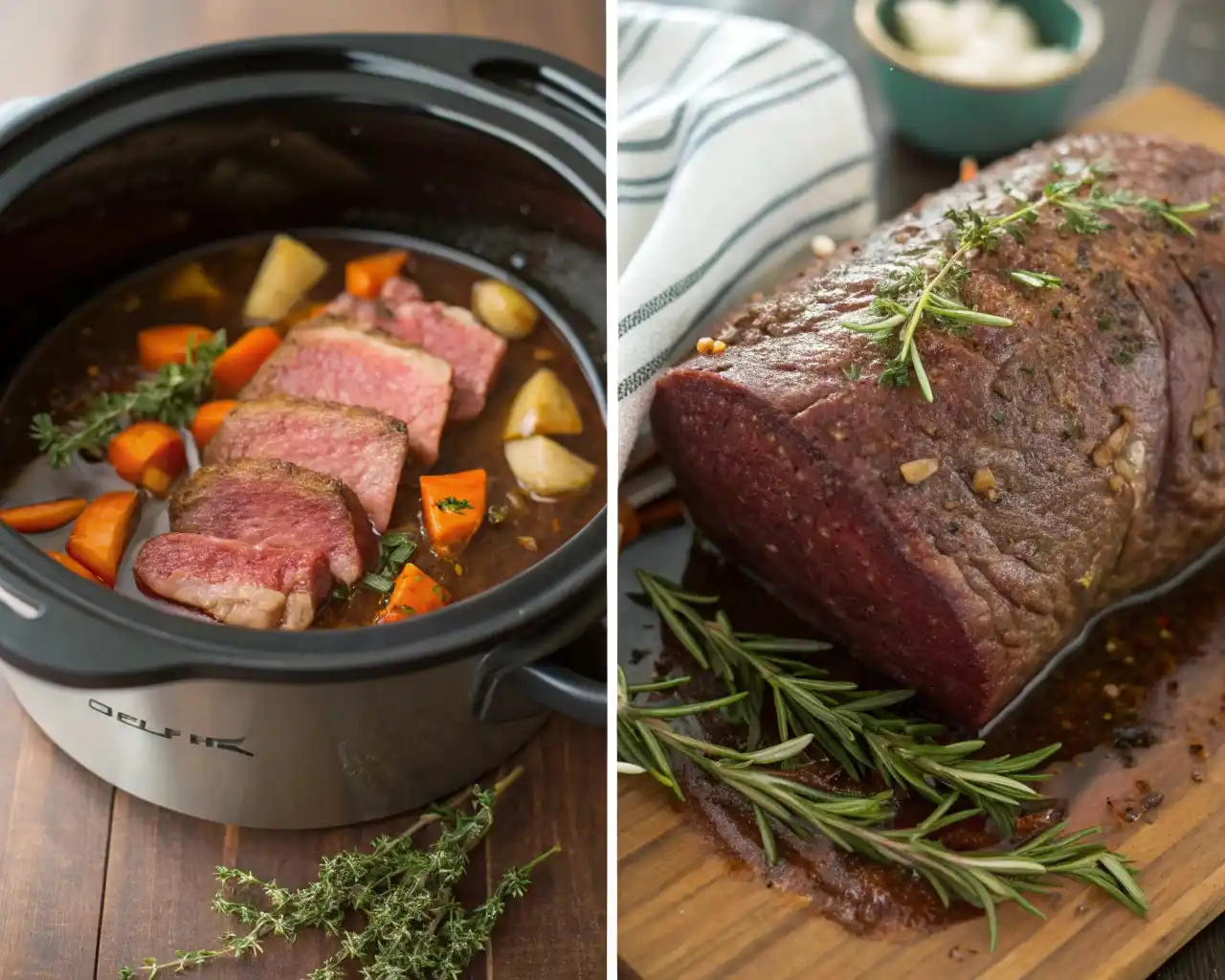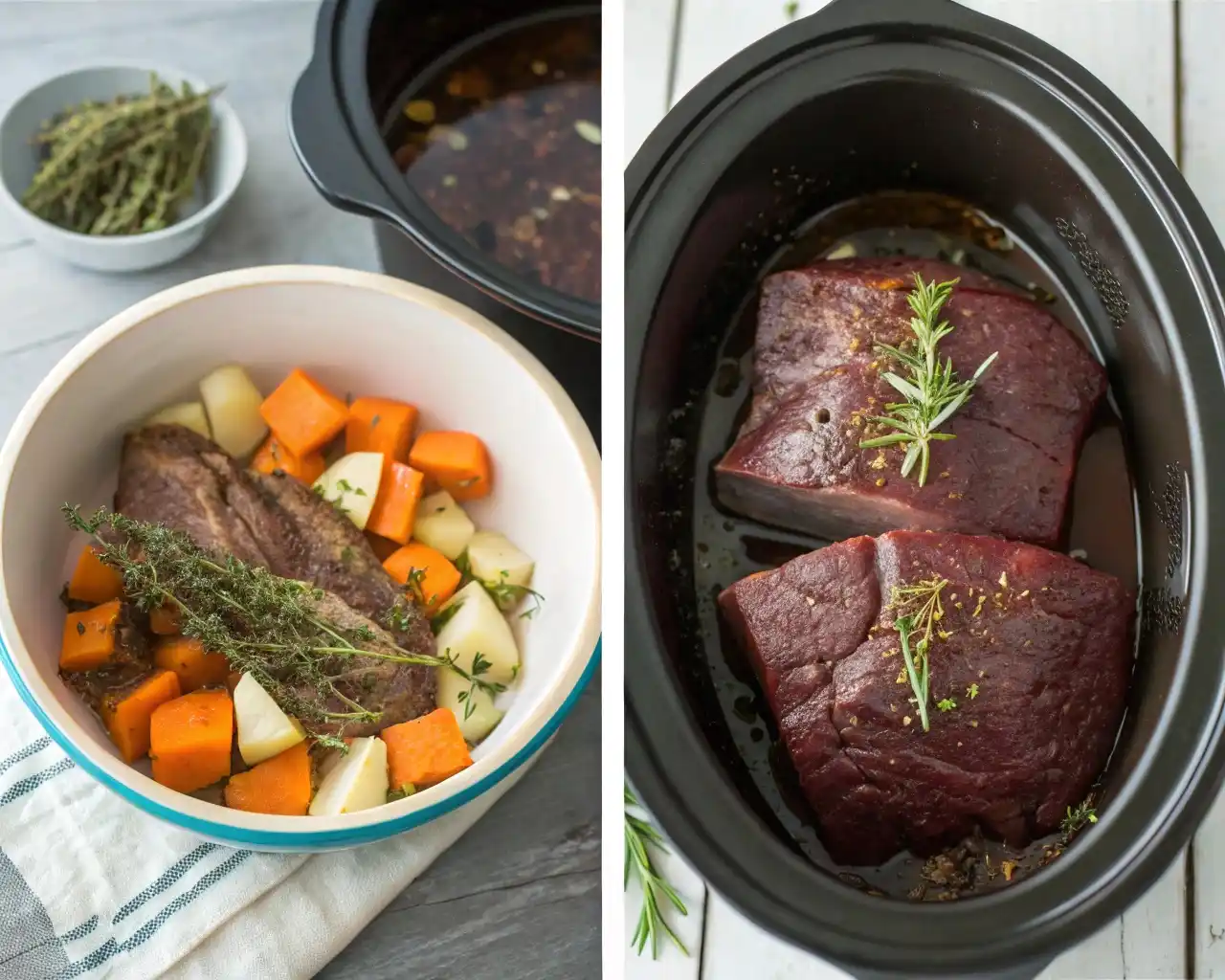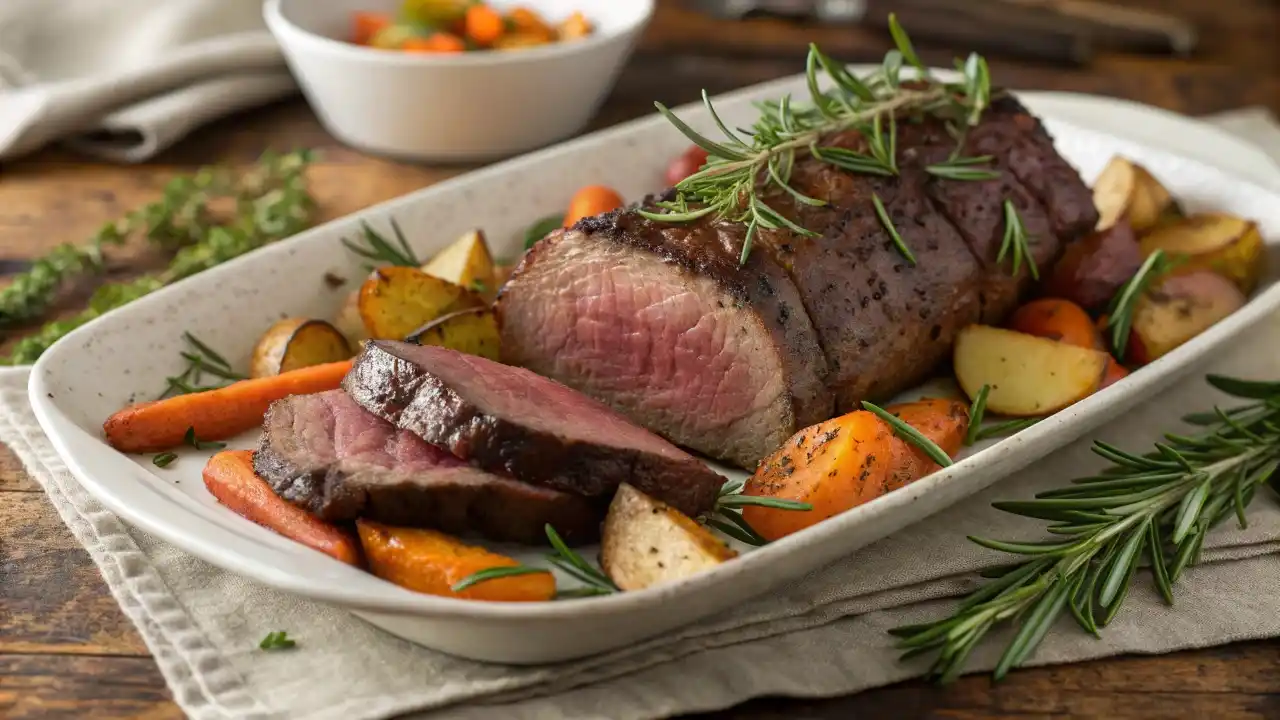Introduction to Venison Roasting
What is Venison?

First things first—what exactly is venison (Deer Roast Recipe)? Simply put, it’s deer meat. But not all venison is the same. Depending on the deer species, diet, and how it was processed, the flavor can range from mild and beef-like to rich and gamey. Unlike beef, venison is naturally lean, which means it cooks differently (and can dry out fast if you’re not careful!).
Why Choose Deer Roast?
If you’ve never cooked with venison before, you might be wondering: Why go for deer roast over regular beef? Well, for one, it’s healthier—venison has less fat, fewer calories, and more protein than beef. Plus, if you or someone you know is a hunter, it’s a great way to make use of fresh, organic meat instead of buying from the store.
Another reason? The taste! A good deer roast recipe gives you something deeply savory and rich, with a slightly sweet, earthy flavor. Cooked right, it’s as tender as a prime rib but way more unique.
Nutritional Benefits of Venison
Worried about eating too much red meat? Venison’s got you covered. It’s packed with iron, B vitamins, and omega-3s, but without all the unhealthy fats you get from store-bought beef. Plus, it’s high in protein—so if you’re looking to bulk up (or just eat cleaner), venison is a great choice.
Selecting the Right Cut for Your Deer Roast
Popular Venison Cuts for Roasting
Before you jump into a deer roast recipe, you need the right cut of meat. Not every part of the deer works well for roasting. The best cuts for a tender, juicy roast are:
- The hindquarter (rump or top round) – Lean, flavorful, and great for slow cooking.
- The shoulder (chuck roast equivalent) – A bit tougher, but with slow cooking, it falls apart beautifully.
- The backstrap? Not so fast! – Some people do roast the backstrap, but honestly, it’s better for steaks or grilling.
Bone-In vs. Boneless: Pros and Cons
Got a choice between bone-in or boneless? Here’s the deal:
- Bone-in roast holds more moisture and adds depth of flavor, but takes longer to cook.
- Boneless roast cooks faster and is easier to slice, but it can dry out quickly if not cooked right.
Tips for Choosing Quality Venison
Not all venison is created equal! The taste of your deer roast recipe depends on a few factors:
- Field dressing matters – If the deer wasn’t processed properly, the meat might have a stronger gamey flavor.
- Age of the deer – Younger deer = more tender meat. Older deer? You’ll need a good marinade and slow cooking!
- Fat is your enemy – Unlike beef, deer fat has a waxy texture and can taste off. Trim it off before cooking.
Preparing Your Venison Roast
Thawing and Cleaning the Meat
If your venison has been in the freezer, don’t rush the thawing process. The best way to thaw a venison roast? Let it defrost slowly in the fridge for 24-48 hours. Need it faster? Stick it in a bowl of cold water, changing the water every 30 minutes.
Once thawed, pat it dry with paper towels and trim off any fat or silver skin (that shiny, tough membrane). This helps avoid that gamey aftertaste some people complain about.
Marinating: Enhancing Flavor and Tenderness
Venison is lean, which means marinating it can work wonders. A good marinade not only adds moisture but also tenderizes the meat.
Best marinade ingredients?
- Acid (like apple cider vinegar, buttermilk, or red wine) breaks down tough fibers.
- Oil (olive oil or melted butter) locks in moisture.
- Aromatics (garlic, onion, rosemary, thyme) bring out the natural flavors.
- Something sweet (brown sugar, honey) balances the richness.
Let your roast sit in the marinade for at least 4-8 hours (overnight is even better).
Seasoning Blends for Deer Roast
If you’re skipping the marinade, at least go heavy on the seasoning. Venison loves bold flavors! Here’s a tried-and-true blend:
- Salt and black pepper – The foundation.
- Garlic and onion powder – Adds depth.
- Smoked paprika – Gives a subtle smoky kick.
- Rosemary and thyme – Classic herbs that pair beautifully with venison.
For a spicy twist, throw in some cayenne pepper. If you love earthy flavors, a bit of ground cumin works wonders.
Cooking Methods for Deer Roast
Cooking venison is a little different from cooking beef—you can’t just throw it in the oven and hope for the best. Because it’s so lean, the wrong method can turn your beautiful cut of meat into something dry and chewy. But don’t worry! These tried-and-true methods will make sure your deer roast recipe comes out tender, juicy, and packed with flavor.
Oven Roasting: Step-by-Step Guide
If you want a classic approach, oven roasting is the way to go. It’s simple, straightforward, and lets you control the cooking process.
- Preheat the oven to 275°F (135°C)—low and slow is key.
- Sear the roast in a hot skillet with butter or oil for 2-3 minutes per side until it gets a nice brown crust.
- Place the roast in a roasting pan and add broth, wine, or even apple cider for moisture.
- Cover and roast until the internal temperature reaches 130-140°F (54-60°C) for medium-rare (use a meat thermometer!).
- Let it rest for at least 15 minutes before slicing—it keeps the juices inside!
Slow Cooker Venison Roast: A Tender Approach
For an ultra-tender roast that falls apart, the slow cooker is your best friend. Here’s how:
- Sear the venison roast in a hot pan to lock in flavor.
- Place it in a slow cooker with broth, onions, garlic, carrots, and herbs.
- Cook on low for 6-8 hours until it’s fork-tender.
- Shred or slice, then serve with mashed potatoes or over rice.
Dutch Oven Techniques for Venison
Dutch ovens are amazing for locking in moisture and making sure your roast comes out flavorful.
- Sear the roast in a Dutch oven over medium-high heat.
- Add liquid (broth, wine, or beer) and aromatics like rosemary and bay leaves.
- Cover and roast at 250°F (120°C) for 4-5 hours.
- Check for tenderness—if it falls apart easily, it’s done!
For more delicious recipes, check out our [recipe article] on other hearty wild game dishes!
Complementary Side Dishes for Deer Roast
A good deer roast recipe is only as good as what you serve with it. You need the right side dishes to round out the meal, add texture, and soak up all that delicious sauce. Here are the best pairings!
Classic Vegetable Pairings
Roasted vegetables are a no-brainer. Their natural sweetness balances out venison’s rich, earthy flavor. Try:
- Carrots, parsnips, and sweet potatoes – Roasted with olive oil, salt, and rosemary.
- Brussels sprouts with bacon – Crispy, smoky, and perfect with venison.
- Garlic green beans – Light, fresh, and a great contrast to a hearty roast.
Grain and Starch Options
Hearty starches help soak up the flavors and juices from your roast. Some of the best options include:
- Mashed potatoes – Creamy, buttery, and a classic for a reason.
- Wild rice – Nutty and slightly chewy, it pairs beautifully with venison.
- Polenta – Soft, cheesy, and a great base for shredded deer roast.
Sauces and Gravies to Pair with Venison
A good sauce takes your deer roast recipe to the next level. Some must-try options:
- Red wine reduction – Deep, rich, and slightly tangy.
- Cranberry sauce – The tartness complements venison perfectly.
- Classic brown gravy – Made with pan drippings for an ultra-flavorful finish.
Need more ideas? Check out our [recipe article] for more comforting dishes to serve with venison!
Cooking Methods for Deer Roast

Cooking venison is a little different from cooking beef—you can’t just throw it in the oven and hope for the best. Because it’s so lean, the wrong method can turn your beautiful cut of meat into something dry and chewy. But don’t worry! These tried-and-true methods will make sure your deer roast recipe comes out tender, juicy, and packed with flavor.
Oven Roasting: Step-by-Step Guide
If you want a classic approach, oven roasting is the way to go. It’s simple, straightforward, and lets you control the cooking process.
- Preheat the oven to 275°F (135°C)—low and slow is key.
- Sear the roast in a hot skillet with butter or oil for 2-3 minutes per side until it gets a nice brown crust.
- Place the roast in a roasting pan and add broth, wine, or even apple cider for moisture.
- Cover and roast until the internal temperature reaches 130-140°F (54-60°C) for medium-rare (use a meat thermometer!).
- Let it rest for at least 15 minutes before slicing—it keeps the juices inside!
Slow Cooker Venison Roast: A Tender Approach
For an ultra-tender roast that falls apart, the slow cooker is your best friend. Here’s how:
- Sear the venison roast in a hot pan to lock in flavor.
- Place it in a slow cooker with broth, onions, garlic, carrots, and herbs.
- Cook on low for 6-8 hours until it’s fork-tender.
- Shred or slice, then serve with mashed potatoes or over rice.
Dutch Oven Techniques for Venison
Dutch ovens are amazing for locking in moisture and making sure your roast comes out flavorful.
- Sear the roast in a Dutch oven over medium-high heat.
- Add liquid (broth, wine, or beer) and aromatics like rosemary and bay leaves.
- Cover and roast at 250°F (120°C) for 4-5 hours.
- Check for tenderness—if it falls apart easily, it’s done!
For more delicious recipes, check out our [recipe article] on other hearty wild game dishes!
Complementary Side Dishes for Deer Roast
A good deer roast recipe is only as good as what you serve with it. You need the right side dishes to round out the meal, add texture, and soak up all that delicious sauce. Here are the best pairings!
Classic Vegetable Pairings
Roasted vegetables are a no-brainer. Their natural sweetness balances out venison’s rich, earthy flavor. Try:
- Carrots, parsnips, and sweet potatoes – Roasted with olive oil, salt, and rosemary.
- Brussels sprouts with bacon – Crispy, smoky, and perfect with venison.
- Garlic green beans – Light, fresh, and a great contrast to a hearty roast.
Grain and Starch Options
Hearty starches help soak up the flavors and juices from your roast. Some of the best options include:
- Mashed potatoes – Creamy, buttery, and a classic for a reason.
- Wild rice – Nutty and slightly chewy, it pairs beautifully with venison.
- Polenta – Soft, cheesy, and a great base for shredded deer roast.
Sauces and Gravies to Pair with Venison
A good sauce takes your deer roast recipe to the next level. Some must-try options:
- Red wine reduction – Deep, rich, and slightly tangy.
- Cranberry sauce – The tartness complements venison perfectly.
- Classic brown gravy – Made with pan drippings for an ultra-flavorful finish.
Serving and Carving Your Deer Roast
Resting the Meat: Why It’s Important
Before you grab that knife and start slicing, hold up! Letting your deer roast rest is just as important as cooking it right.
When meat cooks, the juices get pushed toward the center. If you cut it too soon, all that flavor pours out, leaving you with dry venison. Instead, tent it loosely with foil and let it rest for 15-20 minutes. This lets the juices redistribute, keeping every bite moist and tender.
Carving Techniques for Optimal Presentation
Want those perfect, restaurant-style slices? Here’s how:
- Use a sharp knife – A dull blade will tear the meat and ruin the texture.
- Slice against the grain – This shortens the muscle fibers, making each bite way more tender.
- Aim for thin slices – Venison is lean, so thinner slices help keep it from feeling too chewy.
Plating Ideas for a Stunning Meal
A deer roast recipe deserves a beautiful presentation! Try these plating tips:
- Serve with roasted root veggies on a rustic wooden board.
- Drizzle with red wine reduction for that extra wow factor.
- Garnish with fresh rosemary or thyme for a pop of color.
Storing and Reheating Leftover Venison Roast
Proper Storage Methods
Got leftovers? Lucky you! Venison stores really well—if you do it right.
- Fridge: Store in an airtight container for up to 3-4 days.
- Freezer: Wrap tightly in plastic wrap, then foil, and store for up to 3 months.
- Vacuum sealing? Even better! It keeps venison fresh and prevents freezer burn.
Reheating Without Losing Moisture
Venison is not like beef—it can dry out fast when reheated. Here’s how to warm it up without turning it into leather:
- Oven: Wrap in foil with a splash of broth and heat at 275°F for 15-20 minutes.
- Stovetop: Slice and reheat in a skillet over low heat with butter or gravy.
- Slow Cooker: Works great if you’re reheating a whole roast—low heat for 1-2 hours.
Creative Uses for Leftover Deer Roast
Tired of eating the same thing? Transform your deer roast recipe leftovers into:
- Venison tacos – Shred the meat, add some salsa, and wrap it in a warm tortilla.
- Wild game stew – Toss chopped venison into a hearty vegetable soup.
- Venison sandwiches – Layer with caramelized onions and horseradish sauce on a crusty roll.
For more venison recipe ideas, check out our [recipe article] on creative ways to use wild game!

